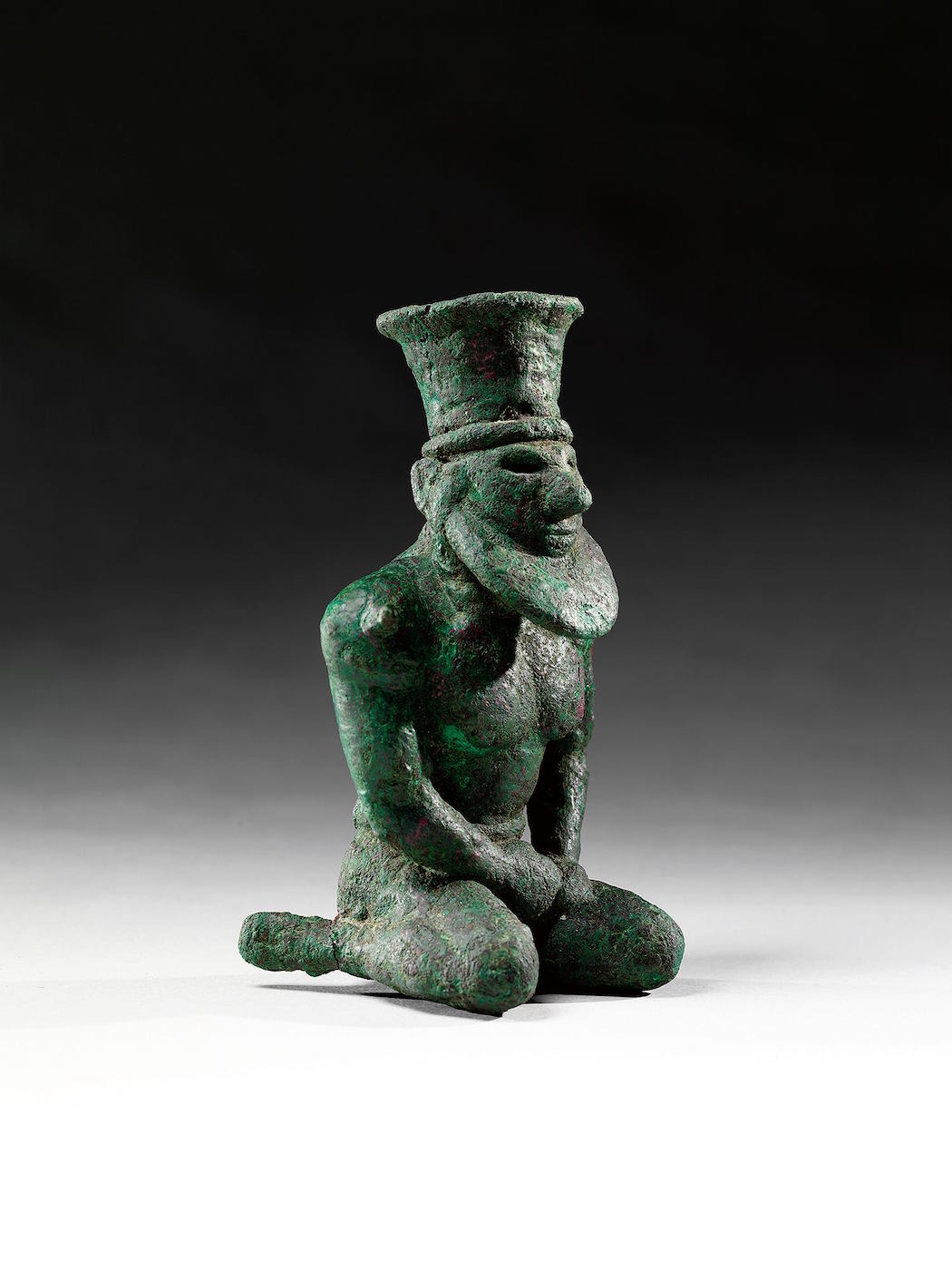
Foundation figure of King Ur-Namma (Neo-Sumerian, Ur III period, reign of Ur-Namma, 2112–2094 BCE), copper alloy. Inscribed in Sumerian: “Ur-Namma, King of Ur, King of Sumer and Akkad, who built the temple of Enlil” (courtesy the Morgan Library & Museum)
The ten statues in Founding Figures: Copper Sculpture from Ancient Mesopotamia, ca. 3300–2000 BC at the Morgan Library & Museum in Manhattan were never meant for our eyes. Interred in the foundations of temples, the copper alloy miniature kings and horned deities, now worn into patinas of emerald-green and reddish-brown, were a hidden tribute to the gods. After the surrounding architecture crumbled, the tiny figures remained buried, until centuries later when archaeologists rediscovered these rare forms of ancient portraiture.

Foundation figure in the form of a nail surmounted by the bust of a god (Sumerian, Early Dynastic III period, 2600–2300 BCE), copper alloy (courtesy private collection, via Morgan Library & Museum) (click to enlarge)
Curated by Sidney Babcock, head of the Department of Ancient Near Eastern Seals and Tablets, the exhibition includes artifacts from the Morgan’s own collections and loans from the Metropolitan Museum of Art, Yale Babylonian Collection, and private collections. Some of the seals from the Morgan are included to give context to the culture around the figures, like one showing figures carrying boxes on their head to an altar. It’s installed alongside a figure balancing a ceremonial box atop its own head.
Colin B. Bailey, the Morgan’s director, writes in a introduction to Founding Figures that this is “the first exhibition in the history of the Morgan Library & Museum devoted to ancient sculpture.” Yet these ancient artifacts were an early focus for founder Pierpont Morgan, who, in the words of collaborator and amateur scholar William Hayes Ward, wanted to “put within the reach of American scholars the material necessary for adding to the knowledge of the world.” In 1907, Morgan acquired the foundation figure that is the centerpiece of Founding Figures: a delicately sculpted statue of the King Ur-Namma from 2112 to 2094 BCE.
Standing with a basket balancing on his head, indicating that in the presence of the gods the king was but a servant, and with cuneiform finely covering a long skirt, the figure of King Ur-Namma represents the perfection of a wax-casting technique that’s now lost. Unearthed from their foundation tombs, the figures are rare survivors of Sumerian art, life, and religion, from the kneeling “priest king” with his authoritative beard to the curious god crowned with horns whose torso abstracts into a long nail shape.
Some of the figures’ inscriptions are illegible, their origins, creators, and even triumphant rulers who dictated their burial consigned to oblivion. What we have are these surprisingly naturalistic faces, rendered in miniature, whose eyes were sculpted to gaze into darkness for eternity, an offering to forgotten gods.

Installation view of ‘Founding Figures: Copper Sculpture from Ancient Mesopotamia, ca. 3300–2000 B.C.’ at the Morgan Library (photo by the author for Hyperallergic)

Figure of a priest king (Mesopotamia, Sumerian, Uruk IV period, 3300-3100 BCE), copper alloy (courtesy private Collection, via the Morgan Library & Museum)

Foundation figure in the form of a peg surmounted by the bust of King Ur-Namma (Neo-Sumerian, Ur III period, reign of Ur-Namma, 2112–2094 BCE), copper alloy. Inscribed in Sumerian: “To Inanna the lady of Eanna, his lady, Ur-Namma the mighty king, King of Ur, King of Sumer and Akkad, her temple he built, to its place he restored it” (courtesy the Metropolitan Museum of Art)

Installation view of ‘Founding Figures: Copper Sculpture from Ancient Mesopotamia, ca. 3300–2000 B.C.’ at the Morgan Library (photo by the author for Hyperallergic)

Foundation figure of a kneeling god holding a peg (Mesopotamia, Second Dynasty of Lagash, reign of Gudea, 2144-2124 BCE), copper alloy (courtesy Morgan Library and Museum)

Installation view of ‘Founding Figures: Copper Sculpture from Ancient Mesopotamia, ca. 3300–2000 B.C.’ at the Morgan Library (photo by the author for Hyperallergic)
Founding Figures: Copper Sculpture from Ancient Mesopotamia, ca. 3300–2000 B.C. continues through August 21 at the Morgan Library and Museum (225 Madison Avenue, Midtown East, Manhattan).

No hay comentarios:
Publicar un comentario